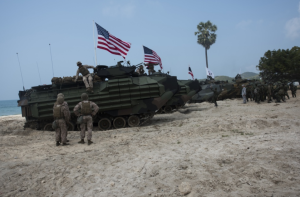Army officials said Tuesday the service does not believe its push to develop new long-range, deep strike fires and work on new concepts for operating as an “inside force” will conflict with Air Force and Marine Corps’ roles for future operations in the Indo-Pacific region.
Gen. James McConville, the Army chief of staff, was asked during a Center for Strategic & International Studies discussion if the service’s emphasis on long-range precision fires modernization could potentially duplicate the Air Force’s fighter and bomber capabilities and result in increased budget risk.

“When we take a look at long-range precision fires, we don’t see that in competition with the great job that the world’s greatest Air Force does as far as striking targets deep. To me, this is about providing options to a combatant commander; options from the land that gives them the capability to, in some ways, to deter with strategic counter-fire or suppress air defense or strike ground targets through a different method and, quite frankly, not necessarily putting pilots at risk,” McConville said.
McConville reiterated previous comments that the Army’s future long-range fires, to include hypersonic weapons and the future Precision Strike Missile, will provide the ability to penetrate adversaries’ Anti-Access/Area Denial (A2/AD) capabilities, opening up more options for the Air Force and Navy in the Indo-Pacific. (Defense Daily, March 12).
The Army also sees complementary roles for its long-range fires and the Marine Corps work to develop its own capability, which includes the new Ground-Based Anti-Ship Missile (GBASM).
“As we take a look at what we’re developing for the Army, these certainly can be used in the Pacific when we look at long-range precision fires. The systems we’re developing are more along the lines of a campaign rather than quick, expeditionary-type systems,” McConville said. “I don’t see us in competition with the Marine Corps. We’ve got a great Marine Corps. They have roles and missions that are extremely important, as does the United States Army.”
Gen. David Berger, the Marine Corps commandant, has called GBASM a critical component for the plan to redesign the force by 2030, and has committed to securing funding in upcoming budgets after the program received cuts for fiscal year 2021 (Defense Daily, Feb. 4).
During the discussion, both McConville and Gen. Paul LaCamera, commander of U.S. Army Pacific, agreed that the Army’s work developing “inside force” capabilities as part of its push toward multi-domain operations won’t conflict with the Marine Corps’ operational role.
“Whether [the Marine Corps] is there first and we come in behind them and that allows them to continue to move on, really it’s based on how do we work well within the concept and design of how the commander of INDOPACOM is going to fight,” LaCamera said.
A new Army paper released last week details capability requirements for its plan to transform into a force prepared for large-scale, multi-domain combat operations by 2035, to include new tactics for operating within adversaries’ A2/AD zones (Defense Daily, March 23).